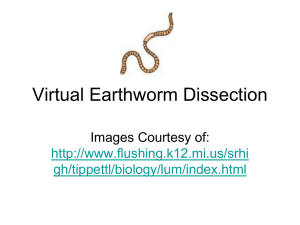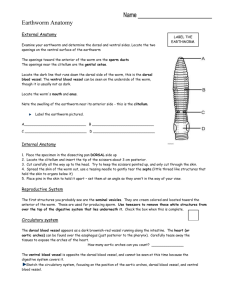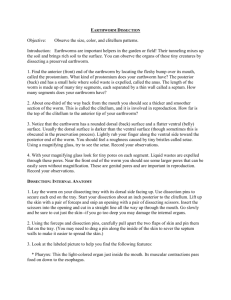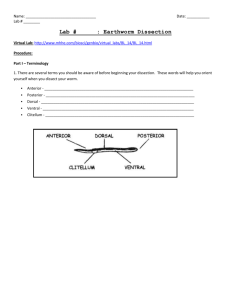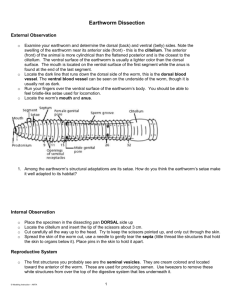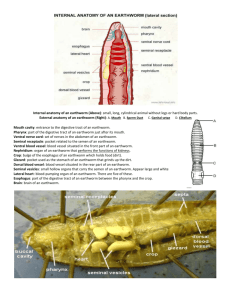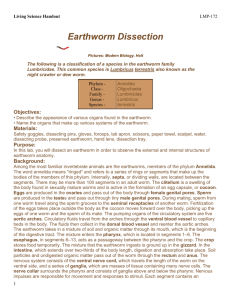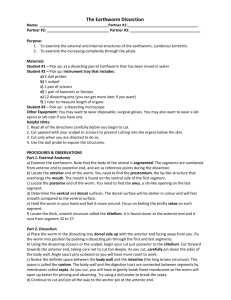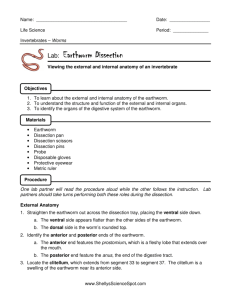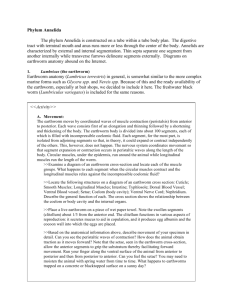Earthworm Dissection Lab Worksheet: Anatomy & Analysis
advertisement
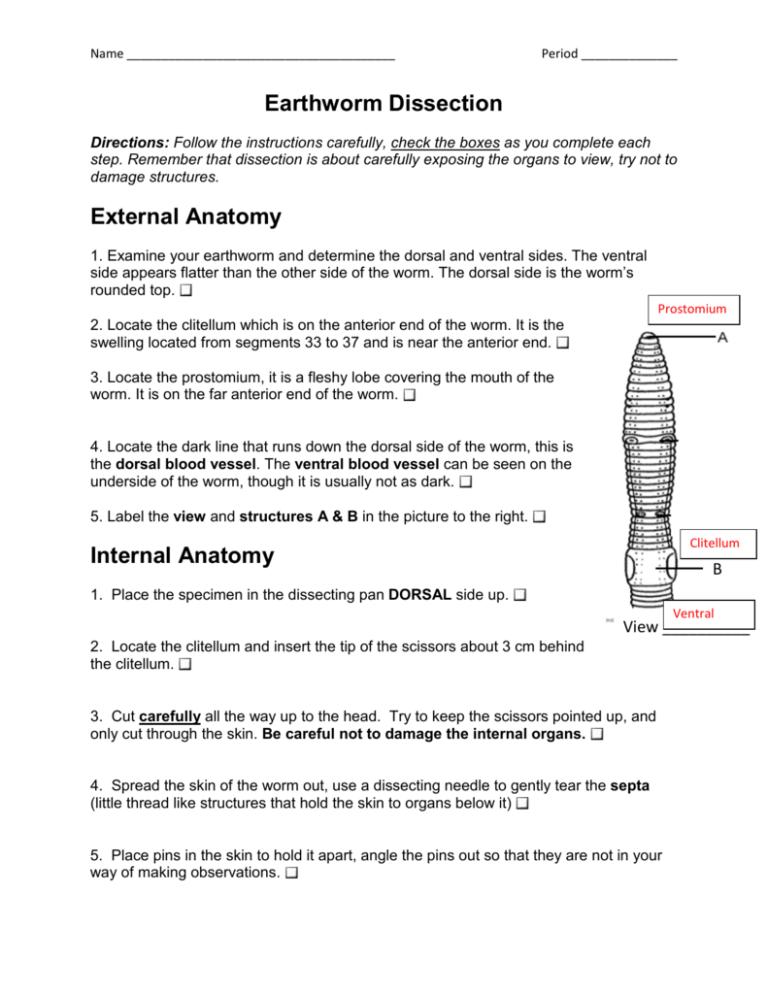
Name _______________________________________ Period ______________ Earthworm Dissection Directions: Follow the instructions carefully, check the boxes as you complete each step. Remember that dissection is about carefully exposing the organs to view, try not to damage structures. External Anatomy 1. Examine your earthworm and determine the dorsal and ventral sides. The ventral side appears flatter than the other side of the worm. The dorsal side is the worm’s rounded top. Prostomium 2. Locate the clitellum which is on the anterior end of the worm. It is the swelling located from segments 33 to 37 and is near the anterior end. 3. Locate the prostomium, it is a fleshy lobe covering the mouth of the worm. It is on the far anterior end of the worm. 4. Locate the dark line that runs down the dorsal side of the worm, this is the dorsal blood vessel. The ventral blood vessel can be seen on the underside of the worm, though it is usually not as dark. 5. Label the view and structures A & B in the picture to the right. Clitellum Internal Anatomy B 1. Place the specimen in the dissecting pan DORSAL side up. Ventral View __________ 2. Locate the clitellum and insert the tip of the scissors about 3 cm behind the clitellum. 3. Cut carefully all the way up to the head. Try to keep the scissors pointed up, and only cut through the skin. Be careful not to damage the internal organs. 4. Spread the skin of the worm out, use a dissecting needle to gently tear the septa (little thread like structures that hold the skin to organs below it) 5. Place pins in the skin to hold it apart, angle the pins out so that they are not in your way of making observations. Name _______________________________________ Period ______________ Reproductive System The first structures you probably see are the seminal vesicles. They are cream colored and located toward the anterior of the worm. These are used for producing sperm. Use forceps to remove these white structures from over the top of the digestive system that lies underneath it. Circulatory system The dorsal blood vessel (X) appears as a dark brownish-red vessel running along the intestine. The heart or aortic arches (Y) can be found over the esophagus (just posterior to the pharynx). Carefully tease away the tissues to expose the arches of the heart, they run across the worm. How many aortic arches can you count? ______ 5 The ventral blood vessel (Z) is opposite the dorsal blood vessel, and cannot be seen at this time because the digestive system covers it. Label the diagram (use the letters next to the bold words above) Y X Z Digestive System The digestive system starts at the mouth. You will trace the organs all the way to the anus and identify each on the worm. Find the mouth opening, the first part after the mouth is the pharynx, you will see stringy things attached to either side of the pharynx (pharyngeal muscles) . The esophagus leads from the pharynx but you probably won’t be able to see it, since it lies underneath the heart . You will find two structures close to the clitellum. First in the order is the crop , followed by the gizzard . Use the dissecting needle to feel the crop and the gizzard . The gizzard leads to the intestine which is as long as the worm and ends at the anus . Name _______________________________________ Period ______________ Use your scissors to cut open the crop and the gizzard. Which one has the harder exterior? ___________ Gizzard Which one (crop or gizzard) would you expect to find the contents to be most ground up? Why? Gizzard, because it is further along in the digestive system and it has the specific job to grind food. Nervous System Locate the brain at the far anterior region of the worm. It is very tiny and whitish colored. If you can't find it, it is probably because it was destroyed when you cut the worm. You CAN locate the ventral nerve cord by removing the intestines and searching for a white string-like structure that runs the length of the worm and attaches to the brain. Remove the intestines and locate the ventral nerve cord. Name _______________________________________ Period ______________ Earthworm Lab Analysis (Answer True of False; most of the answers can be found in this worksheet) 1. ____ The brain attaches to the ventral nerve cord. T 2. ____ The dorsal side of the worm is lighter than the ventral side. F 3. ____ The clitellum is located toward the anterior end of the worm. T 4. ____ The esophagus lies beneath the pharynx F 5. ____ The ventral nerve cord and the ventral blood vessel are connected. 6. ____ An earthworm has fourteen aortic arches. F 7. ____ Seminal vesicles are part of the worm's digestive system. F T 8. Label these structures on the image below: pharynx, esophagus, crop, gizzard, aortic arches, brain, dorsal blood vessel, clitellum, intestine, seminal vesicles. Intestine Gizzard Crop Dorsal Blood Vessel Seminal Vesicles Pharynx Brain Esophagus Aortic Arches Clitellum 9. In the diagram above, color the digestive structures green, the circulatory structures red, the reproductive structures blue, and the nervous system structures yellow. Name _______________________________________ Period ______________ 10. What structure in the earthworm has a similar function as the human heart? Explain your answer. Aortic Arches, serve as similar function as the human heart because they move blood throughout the body. 11. Do earthworms have an anterior and a posterior? Explain your answer. Yes they do have an anterior and a posterior, the majority of the earthworms organs are concentrated in the anterior end, and the posterior is primarily intestine and blood vessel 12. What characteristics distinguish an annelid from other worms? Bilateral symmetry, typically reproduce sexually, hermaphroditic, no respiratory organs, closed circulatory system 13. Does the earthworm have a closed or open circulatory system? Explain your choice. This is an example of a closed circulatory system, because the blood is completely contained within the vessels and aortic arches. 14. Place in the correct order (number) _7___ Anus _4___ Crop _1___ Mouth _5___ Gizzard _3__ Esophagus _6___ Intestine _2___ Pharynx Name _______________________________________ Period ______________ Analysis: Use the comparison chart to summarize the similarities and differences between the blackworm and the earthworm. Be specific! Use vocabulary used throughout the worm unit. Differences: Traits of a Blackworm 1. Traits of an Earthworm 1. Aquatic Terrestrial 2. 2. Up to 10 cm in length Up to 25 cm in length 3. 3. 150-250 body segments About 150 body segments 4. 4. Chaetae hairs for grip Setae hairs for gripping soil Similarities: 1. Circulatory System 2. Digestive System 3. Segmented 4. Can regenerate Name _______________________________________ Period ______________

